It looks like you're using an Ad Blocker.
Please white-list or disable AboveTopSecret.com in your ad-blocking tool.
Thank you.
Some features of ATS will be disabled while you continue to use an ad-blocker.
28
share:
Researchers produce genetic atlas of human
mixing
I always feel like I'm reading about the first run of a new car model when I hear the phrase 'New Approach" It's almost like I should wait until the work the bugs out and wait for next years model. If this is fairly accurate they may be able to start answering some questions but the example given only goes back about 4,000 years. That's pretty good, I was hoping for something a bit further back.
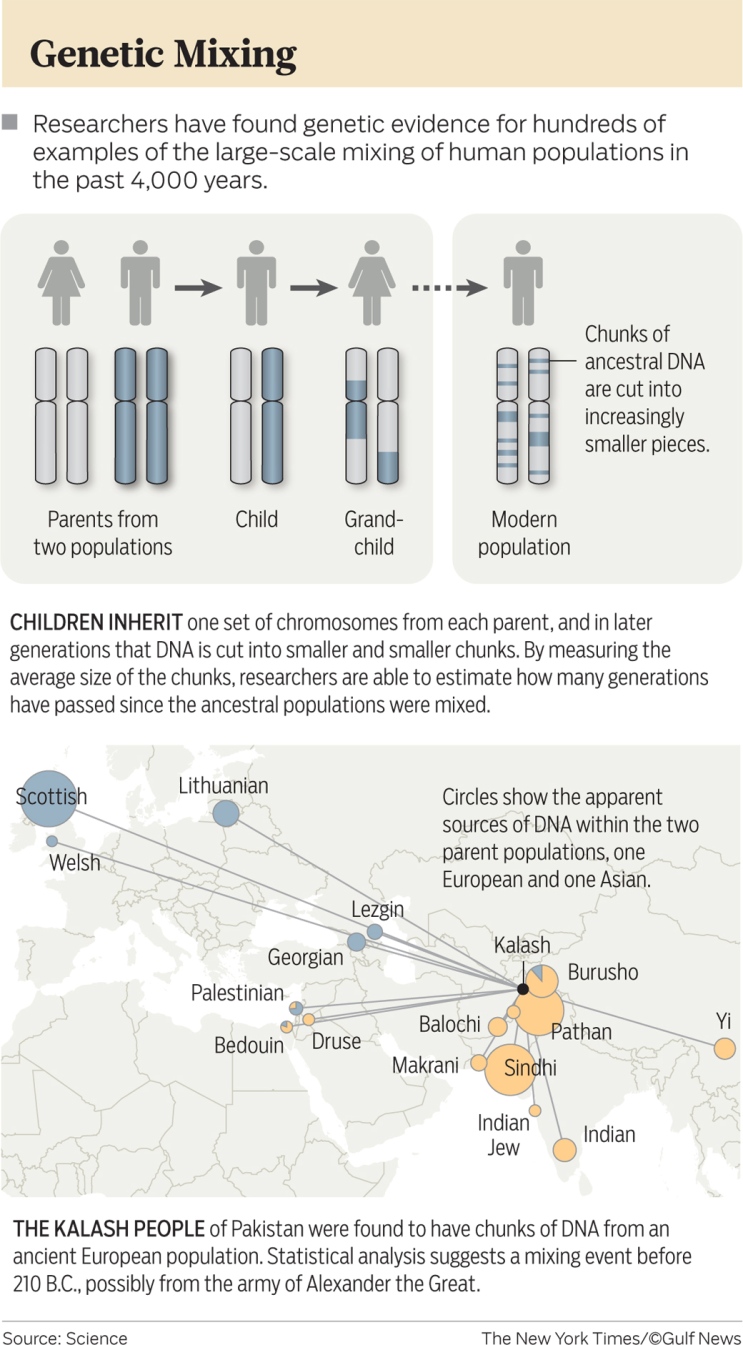
Washington: The rise and fall of empires, the march of armies, the flow of trade routes, the practice of slavery — all these events have led to a mixing of populations around the world. Such episodes have left a record in the human genome, but one that has so far been too complex to decipher on a global scale.
Now, geneticists applying new statistical approaches have taken a first shot at both identifying and dating the major population mixture events of the last 4,000 years, with the goal of providing a new source of information for historians.
Some of the hundred or so major mixing events they describe have plausible historical explanations, while many others remain to be accounted for. For instance, many populations of the southern Mediterranean and Middle East have segments of African origin in their genomes that were inserted at times between AD650 and 1900, according to the geneticists’ calculations. This could reflect the activity of the Arab slave trade, which originated in the seventh century, and the absorption of slaves into their host populations.
The lowest amount of African admixture occurs in the Druse, a religious group of the Middle East that prohibited slavery and has been closed to converts since 1043.
I always feel like I'm reading about the first run of a new car model when I hear the phrase 'New Approach" It's almost like I should wait until the work the bugs out and wait for next years model. If this is fairly accurate they may be able to start answering some questions but the example given only goes back about 4,000 years. That's pretty good, I was hoping for something a bit further back.

reply to post by SLAYER69
Pretty cool,
Notice how all the parent DNA sources come from areas near the sea.
Yes, most civilizations spring from areas near water sources, but this could also be further evidence leading to lost sea faring civilizations. Would be interesting to see what comes of them testing the DNA of ancient coastal civilizations.
Pretty cool,
Notice how all the parent DNA sources come from areas near the sea.
Yes, most civilizations spring from areas near water sources, but this could also be further evidence leading to lost sea faring civilizations. Would be interesting to see what comes of them testing the DNA of ancient coastal civilizations.
I see from the link that this "atlas" has just been published in the journal "Science".
Could be worth tracking down for those who want more detail.
Could be worth tracking down for those who want more detail.
reply to post by SLAYER69
Ok. This is interesting indeed.
Seems like they are doing more and more with DNA than ever before.
So what I wonder is... the further and further back they are able to show that the different races/cultures mixed and be able to prove it, what purpose will it serve ? What will it prove ? What will it make us learn ? Please give me some examples.
Are they looking for someone who is still "pure" ? & I'm not asking this in an offensive manner to anyone. I'm just wondering on the whys.
Is it just to know our history even further... what exactly are they searching for ?
I wonder who is funding the research ? hmmm
leolady
Ok. This is interesting indeed.
Seems like they are doing more and more with DNA than ever before.
So what I wonder is... the further and further back they are able to show that the different races/cultures mixed and be able to prove it, what purpose will it serve ? What will it prove ? What will it make us learn ? Please give me some examples.
Are they looking for someone who is still "pure" ? & I'm not asking this in an offensive manner to anyone. I'm just wondering on the whys.
Is it just to know our history even further... what exactly are they searching for ?
I wonder who is funding the research ? hmmm
leolady
edit on 15-2-2014 by leolady because: (no reason given)
reply to post by watchitburn
That's kind of what I was hoping for when I first read this. To see if there were any connections between the Cradle Civs. Could of meant either trade with each other in prehistory or even they coming from a much older now forgotten past.
Funny how the way they find Denisovian DNA from Russia/Siberia out in the Pacific region dispersed...
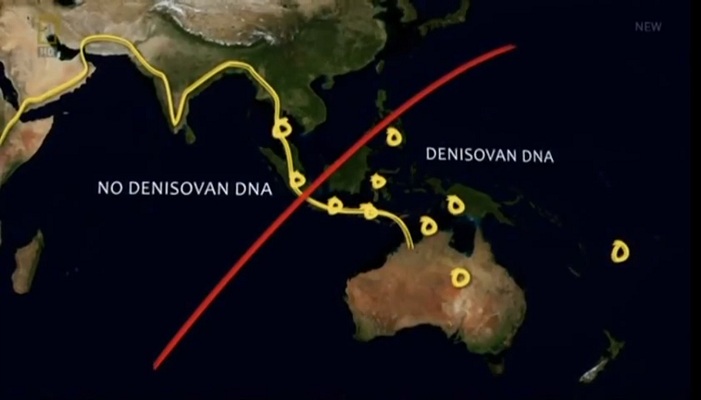
That's kind of what I was hoping for when I first read this. To see if there were any connections between the Cradle Civs. Could of meant either trade with each other in prehistory or even they coming from a much older now forgotten past.
Funny how the way they find Denisovian DNA from Russia/Siberia out in the Pacific region dispersed...

One of the more interesting aspects of the ever more complex DNA studies is that they have corroborated the findings of paleontology and anthropology
vis-à-vis human origins. To my knowledge there has not yet been a situation where the two methods have yielded contrary results--especially upon
close examination. Organizations such as "23 and me" and the National Genographic Project have also brought DNA studies to the masses for a fairly
reasonable price. It wont be too long before everyone could have their entire genome sequenced inexpensively.
Given these developments it would seem likely that IF there were any credence to past civilizations with non-trivial populations, i.e.: Those who had managed to garner the resources and knowledge necessary to map the globe or similar intellectual or engineering feats, then this should show up in properly designed genetic studies. If we can say for certain today that modern Europeans have from 2-4% Neanderthal DNA, then surely the granularity of DNA knowledge is sufficient to pick up this possibility--should it exist and also be recognized. If the soldiers of Alexander the Great can be picked up in Pakistan, then the population of Atlantis or Lemuria must also cast a shadow, however faintly, on modern populations.
This is not something I would expect a tenured geneticist to spend time contemplating, but surely there are qualified people out there who might, you know, "accidentally" stumble on a similar issue that might be catalogued for future study.
Note: I see we're cross-posting time wise. My own DNA came back 2.7% Neanderthal in two different studies, but also about 4% Denisovan in one. Most everything else is Scott/Irish with a bit of West Africa and Germanic thrown in for good measure.
Given these developments it would seem likely that IF there were any credence to past civilizations with non-trivial populations, i.e.: Those who had managed to garner the resources and knowledge necessary to map the globe or similar intellectual or engineering feats, then this should show up in properly designed genetic studies. If we can say for certain today that modern Europeans have from 2-4% Neanderthal DNA, then surely the granularity of DNA knowledge is sufficient to pick up this possibility--should it exist and also be recognized. If the soldiers of Alexander the Great can be picked up in Pakistan, then the population of Atlantis or Lemuria must also cast a shadow, however faintly, on modern populations.
This is not something I would expect a tenured geneticist to spend time contemplating, but surely there are qualified people out there who might, you know, "accidentally" stumble on a similar issue that might be catalogued for future study.
Note: I see we're cross-posting time wise. My own DNA came back 2.7% Neanderthal in two different studies, but also about 4% Denisovan in one. Most everything else is Scott/Irish with a bit of West Africa and Germanic thrown in for good measure.
edit on 2/15/2014 by schuyler because: (no
reason given)
reply to post by schuyler
Well that makes sense to me, seems a pretty logical way to find out if there has been advanced civilizations equal or greater then where we currently are.
Well that makes sense to me, seems a pretty logical way to find out if there has been advanced civilizations equal or greater then where we currently are.
reply to post by schuyler
What if those much older original lines from say early now lost/forgotten Civilizations *Now Flooded locations* were already in the region of those that came later or survivors of large scale coastal flooding?
Hypothetical
What if those much older original lines from say early now lost/forgotten Civilizations *Now Flooded locations* were already in the region of those that came later or survivors of large scale coastal flooding?
Hypothetical
The Ancient Aegean.
[atsimg]http://files.abovetopsecret.com/images/member/fde840ea31d2.jpg[/atsimg]vs
The Modern Aegean.
[atsimg]http://files.abovetopsecret.com/images/member/ff55edb41226.jpg[/atsimg]edit on 15-2-2014 by SLAYER69 because: (no reason given)
reply to post by SLAYER69
Yes, along the same lines. Perhaps I'm putting more stock in DNA than is possible to extract, but the science as it exists today seems to be able to pull out very nuanced facts from not all that much material. You'd almost need to "know what you are looking for" a priori, with all the hazards that implies. For example, the Greeks of today are not the same population that populated that area 2500 years ago. They look nowhere near like the statues of the ancients, but are very likely heavily influenced by invading armies from the east and north. The same is true of southern Italy. Hannibal roamed the countryside pretty much unmolested for years without conquering Rome, with obvious results. Perhaps if something like that were accomplished it would be called something like "Proto-Greek" without recognizing the implications.
I don't know if such a feat could be accomplished, of course. It's just an idea. I notice several here are kind of thinking along the same lines, wondering if there is not some sort of connection that could be established.
Yes, along the same lines. Perhaps I'm putting more stock in DNA than is possible to extract, but the science as it exists today seems to be able to pull out very nuanced facts from not all that much material. You'd almost need to "know what you are looking for" a priori, with all the hazards that implies. For example, the Greeks of today are not the same population that populated that area 2500 years ago. They look nowhere near like the statues of the ancients, but are very likely heavily influenced by invading armies from the east and north. The same is true of southern Italy. Hannibal roamed the countryside pretty much unmolested for years without conquering Rome, with obvious results. Perhaps if something like that were accomplished it would be called something like "Proto-Greek" without recognizing the implications.
I don't know if such a feat could be accomplished, of course. It's just an idea. I notice several here are kind of thinking along the same lines, wondering if there is not some sort of connection that could be established.
leolady
Are they looking for someone who is still "pure" ?
There is no such thing as a "pure" human being. There has been so much mixing throughout history. We all came from one source anyways. We are all direct descendents of Africans, considering that human life began there. We're all related in a way, so there's really no point in even discussing who mixed with who to create who and when.
Genetic/racial supremacists are ignorant fools, and this right here is the proof.
edit on 15-2-2014 by Xaphan because: (no reason
given)
I appreciate the feedback both pro and con. some interesting replies thus far.
Thanks
Thanks
Interesting find. Some more details on the report from The Telegraph. To access the INTERACTIVE map you need to click on the link below, there are
instructions there.
Tel egraph article, map and instructions
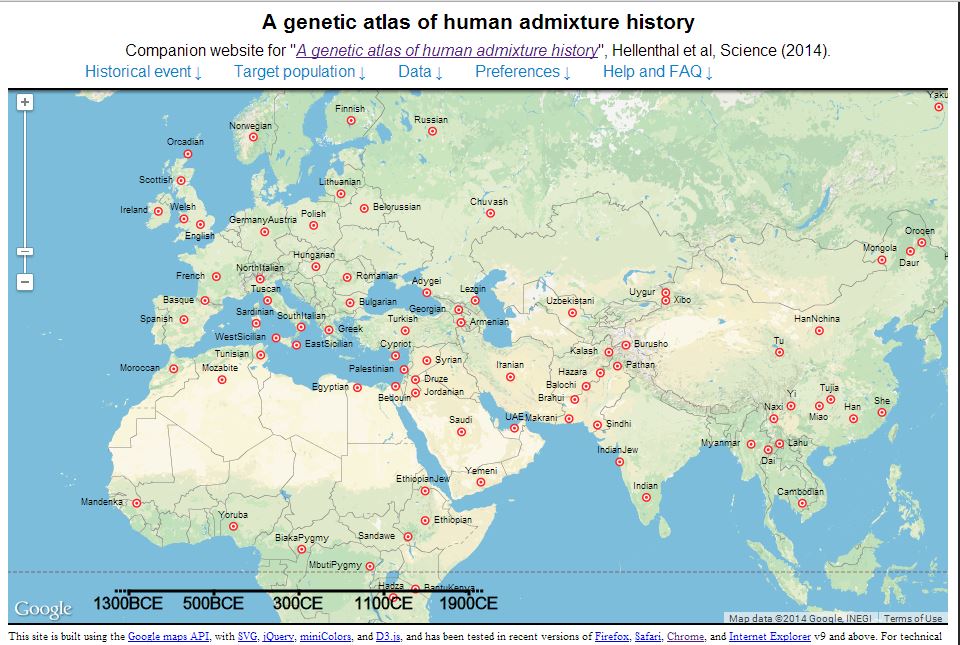
www.sciencemag.org...
An example
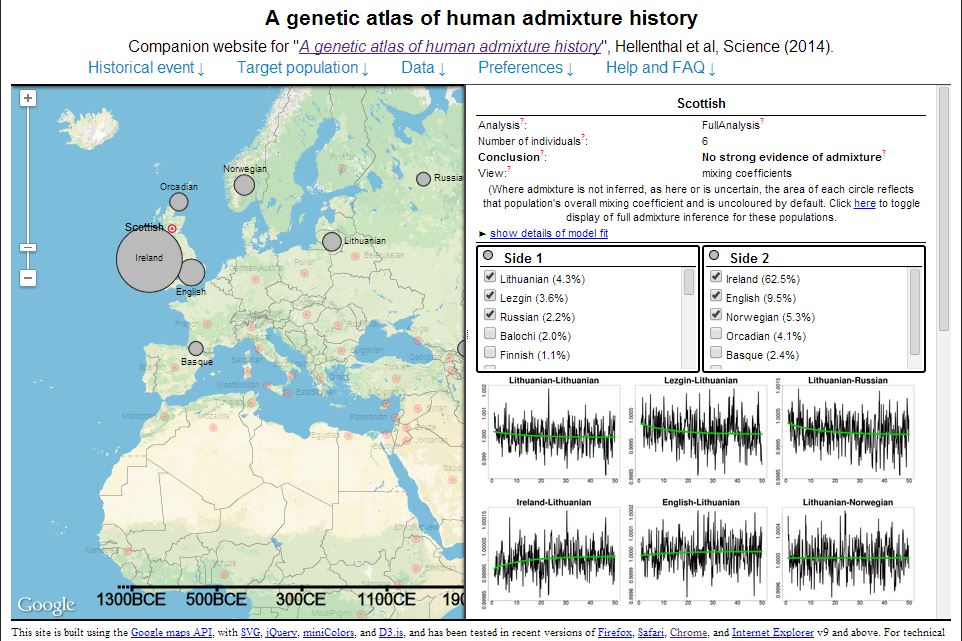
Tel egraph article, map and instructions

This interactive map summarizes the results described in the paper "A genetic atlas of human admixture history", Hellenthal et al, Science (2014). This help page gives a brief summary of the content and structure of the page. (We also suggest reading the FAQ and the tutorial accessible under the 'Historical event' menu.) To begin, click on a labelled population on the map (or select one from the "Target" drop-down menu at top). You will see displayed details of past admixture events which we infer to have occurred in forming that population.
A global map which details the genetic make-up of 95 populations across the world shows the impact of European Colonialism, the spread of the Mongol Empire and the Arab slave trade.
The map, produced by Oxford University, details the histories of genetic mixing between each of the 95 populations across Europe, Africa, Asia and South America spanning the last four millennia.
Researchers analysed the DNA of 1490 individuals across the world and compared the changes to important dates in history.
“DNA really has the power to tell stories and uncover details of humanity's past,”said Dr Simon Myers of Oxford University's Department of Statistics.
“Because our approach uses only genetic data, it provides information independent from other sources.”
Many of our genetic observations match historical events, and we also see evidence of previously unrecorded genetic mixing.
For example, the DNA of the Tu people in modern China suggests that in around 1200CE, Europeans similar to modern Greeks mixed with an otherwise Chinese-like population.
The source of this European-like DNA is likely to be merchants travelling the nearby Silk Road.
Historical records suggest that the Hazara people of Pakistan are partially descended from Mongol warriors, and this study found clear evidence of Mongol DNA entering the population during the period of the Mongol Empire.
Six other populations, from as far west as Turkey, showed similar evidence of genetic mixing with Mongols around the same time.
'What amazes me most is simply how well our technique works,' said Dr Garrett Hellenthal of the UCL Genetics Institute, lead author of the study.
“Although individual mutations carry only weak signals about where a person is from, by adding information across the whole genome we can reconstruct these mixing events.
“Sometimes individuals sampled from nearby regions can have surprisingly different sources of mixing.”
“For example, we identify distinct events happening at different times among groups sampled within Pakistan, with some
inheriting DNA from sub-Saharan Africa, perhaps related to the Arab Slave Trade, others from East Asia, and yet another from ancient Europe.
“Nearly all our populations show mixing events, so they are very common throughout recent history and often involve people migrating over large distances.'
The team used genome data for all 1490 individuals to identify 'chunks' of DNA that were shared between individuals from different populations.
Populations sharing more ancestry share more chunks, and individual chunks give clues about the underlying ancestry along chromosomes.
'Each population has a particular genetic 'palette', said Dr Daniel Falush of the Max Planck Institute for Evolutionary Anthropology in Leipzig, co-senior author of the study.
'If you were to paint the genomes of people in modern-day Maya, for example, you would use a mixed palette with colours from Spanish-like, West African and Native American DNA.
“This mix dates back to around 1670CE, consistent with historical accounts describing Spanish and West African people entering the Americas around that time.
“Though we can't directly sample DNA from the groups that mixed in the past, we can capture much of the DNA of these original groups as persisting, within a mixed palette of modern-day groups. This is a very exciting development.”
As well as providing fresh insights into historical events, the new research might have implications for how DNA impacts health and disease in different populations.
The study was published in the journal Science.
www.sciencemag.org...
An example

edit on 16-2-2014 by theabsolutetruth because: (no reason given)
reply to post by Xaphan
There is no real proof of the geographical origins of humanity, there could well be ancestors far older than those already found that give other pictures.
There is no real proof of the geographical origins of humanity, there could well be ancestors far older than those already found that give other pictures.
Small wonder why they don't want to talk to historians. So they are saying that Africans never left Africa until almost 700AD? Are they implying that
if it hadn't been for slavery Africans would have never left Africa because that makes no sense.
buster2010
Small wonder why they don't want to talk to historians. So they are saying that Africans never left Africa until almost 700AD? Are they implying that if it hadn't been for slavery Africans would have never left Africa because that makes no sense.
I haven't seen anyone making that claim.
All they are saying is that they can detect examples of populations getting mixed, with approximate dates, and tentatively link them with known historical events. Like slavery. Like the Silk Route.
The thoery would be that once part of the human race left Africa, the ones left behind would develop further, genetically speaking, and that's how a fresh set of emigrations (e.g. slavery) could be detected.
edit on 16-2-2014 by DISRAELI because: (no reason given)
Another data map timeline from the data used in the admixture map.
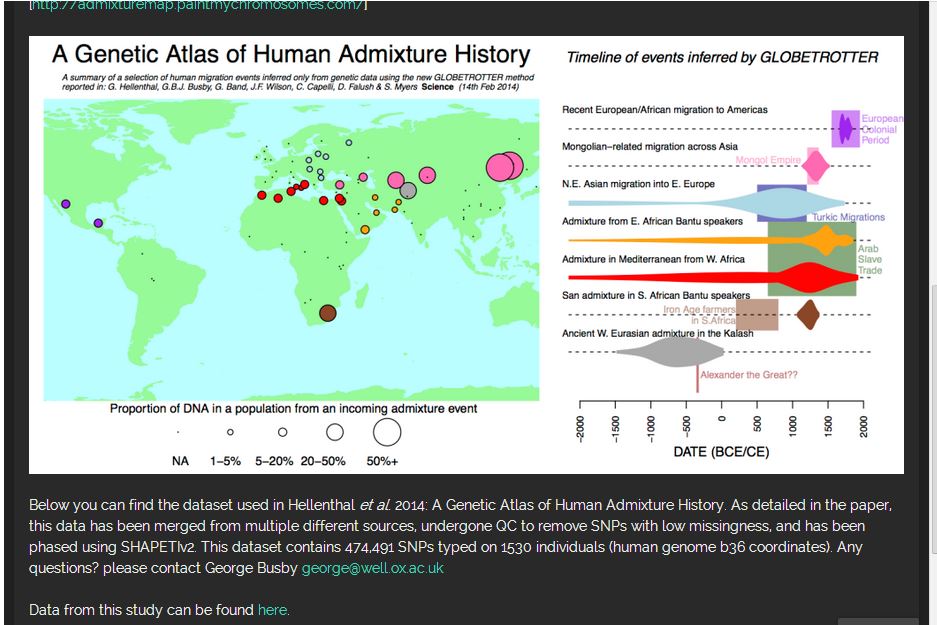
Direct link to admixture map
admixturemap.paintmychromosomes.com...

Direct link to admixture map
admixturemap.paintmychromosomes.com...
The team used genome data for all 1490 individuals to identify 'chunks' of DNA that were shared between individuals from different populations.
Populations sharing more ancestry share more chunks, and individual chunks give clues about the underlying ancestry along chromosomes.
'Each population has a particular genetic 'palette', said Dr Daniel Falush of the Max Planck Institute for Evolutionary Anthropology in Leipzig, co-senior author of the study.
The team used genome data for all 1490 individuals to identify 'chunks' of DNA that were shared between individuals from different populations.
Populations sharing more ancestry share more chunks, and individual chunks give clues about the underlying ancestry along chromosomes.
'Each population has a particular genetic 'palette', said Dr Daniel Falush of the Max Planck Institute for Evolutionary Anthropology in Leipzig, co-senior author of the study.
'If you were to paint the genomes of people in modern-day Maya, for example, you would use a mixed palette with colours from Spanish-like, West African and Native American DNA.
“This mix dates back to around 1670CE, consistent with historical accounts describing Spanish and West African people entering the Americas around that time.
“Though we can't directly sample DNA from the groups that mixed in the past, we can capture much of the DNA of these original groups as persisting, within a mixed palette of modern-day groups. This is a very exciting development.”
As well as providing fresh insights into historical events, the new research might have implications for how DNA impacts health and disease in different populations.
edit on 16-2-2014 by theabsolutetruth because: (no reason given)
new topics
-
Watch SpaceX Starship Test Flight 6 Live - Launch Starts 4pm CST , 2200 GMT.
Space Exploration: 44 minutes ago -
Watch Dramatic Moment Ukrainian Nursery Teacher Takes Out Russian Missile With Rocket Launcher
Mainstream News: 1 hours ago -
He Had and It Has
Short Stories: 5 hours ago -
Morning’s Reverie
Short Stories: 8 hours ago -
Democrat county officials openly declare intention to commit ballot fraud in PA
2024 Elections: 11 hours ago
top topics
-
DefCon Teetering on Escalation
World War Three: 13 hours ago, 27 flags -
Whistleblower warns FBI can’t be trusted with background checks for Trump’s nominees
Whistle Blowers and Leaked Documents: 17 hours ago, 17 flags -
Democrat county officials openly declare intention to commit ballot fraud in PA
2024 Elections: 11 hours ago, 12 flags -
What is your most awesome achievement or proudest moment, RE: something you were responsible for?
General Chit Chat: 16 hours ago, 9 flags -
Morning’s Reverie
Short Stories: 8 hours ago, 3 flags -
He Had and It Has
Short Stories: 5 hours ago, 2 flags -
Watch Dramatic Moment Ukrainian Nursery Teacher Takes Out Russian Missile With Rocket Launcher
Mainstream News: 1 hours ago, 1 flags -
Watch SpaceX Starship Test Flight 6 Live - Launch Starts 4pm CST , 2200 GMT.
Space Exploration: 44 minutes ago, 1 flags
active topics
-
DefCon Teetering on Escalation
World War Three • 30 • : ADVISOR -
The Acronym Game .. Pt.4
General Chit Chat • 973 • : Encia22 -
-@TH3WH17ERABB17- -Q- ---TIME TO SHOW THE WORLD--- -Part- --44--
Dissecting Disinformation • 3303 • : RelSciHistItSufi -
Watch Dramatic Moment Ukrainian Nursery Teacher Takes Out Russian Missile With Rocket Launcher
Mainstream News • 4 • : McUrnsalso -
He Had and It Has
Short Stories • 2 • : nugget1 -
Watch SpaceX Starship Test Flight 6 Live - Launch Starts 4pm CST , 2200 GMT.
Space Exploration • 0 • : gortex -
What is your most awesome achievement or proudest moment, RE: something you were responsible for?
General Chit Chat • 19 • : AlroyFarms -
WATCH LIVE: US Congress hearing on UFOs, unidentified anomalous phenomena
Aliens and UFOs • 131 • : Lazy88 -
Whistleblower warns FBI can’t be trusted with background checks for Trump’s nominees
Whistle Blowers and Leaked Documents • 9 • : billxam1 -
Mood Music Part VI
Music • 3705 • : BrucellaOrchitis
28
